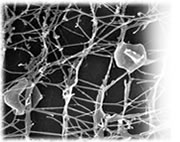|
PHYSIOLOGY
OF THERMOPHILES AND HYPERTHERMOPHILES
Hyperthermophiles?
Hyperthermophiles are microorganisms with the ability
to grow optimally at temperatures higher than 80ºC.
These amazing creatures inhabit volcanic environments
like solfataras, hot springs, deep-sea vents, and geysers.
Some
of these microorganisms are able to grow at 113ºC!
This is the case of the archaeon Pyrolobus fumarii,
the present record holder of thermophily.
Why
hyperthermophiles?
The
discovery of these exotic beings radically changed our
views on biodiversity and posed intriguing questions
about structure stability, opening new avenues for research
in several areas.
 Nearly
all hyperthermophiles isolated so far belong to the
Domain Archaea, close to the root of the tree of Life,
and are believed to represent the most ancient phylogenetic
lineages. The elucidation of metabolic strategies in
these ancestors of Life on Earth is expected to provide
insight into the evolution of metabolic pathways and
mechanisms of thermoadaptation. Nearly
all hyperthermophiles isolated so far belong to the
Domain Archaea, close to the root of the tree of Life,
and are believed to represent the most ancient phylogenetic
lineages. The elucidation of metabolic strategies in
these ancestors of Life on Earth is expected to provide
insight into the evolution of metabolic pathways and
mechanisms of thermoadaptation.
In
order to protect cellular structures from thermal inactivation,
hyperthermophiles must have developed strategies of
thermostabilisation that, once understood, may be used
in many industrial processes such as enzyme-catalysed
conversions, often carried out in extreme environmental
conditions.
Current research lines

Several years ago our group launched a research project
to elucidate biochemical strategies for adaptation of
life at high temperature.
Although many enzymes derived from hyperthermophiles
are intrinsically heat-stable, this is not a general
feature and suggests the presence of extrinsic stabilisation
factors, like compatible solutes. In this view, one
of these research lines set out to investigate the occurrence
and role of compatible solutes in hyperthermophiles.
 As
a result of this effort, several novel organic solutes
have been identified and characterised, and for some
of these solutes, like mannosylglycerate (MG) and diglycerolphosphate
(DGP), their efficiency as protein protectors was clearly
demonstrated, giving rise to two European patents. As
a result of this effort, several novel organic solutes
have been identified and characterised, and for some
of these solutes, like mannosylglycerate (MG) and diglycerolphosphate
(DGP), their efficiency as protein protectors was clearly
demonstrated, giving rise to two European patents.
 These
findings made us move into three directions: one is
the understanding of the stabilisation phenomenon, using
model proteins (like staphylococcal nuclease and D.
gigas rubredoxin) to reveal both at the thermodynamic
as well as at the molecular level the mechanisms that
lead to increased stability. Another aim is the design
of new solutes that may have an even greater stabilising
ability (solute engineering). This synthesis work is
carried out in collaboration with Prof. C. Maycock at
ITQB. These
findings made us move into three directions: one is
the understanding of the stabilisation phenomenon, using
model proteins (like staphylococcal nuclease and D.
gigas rubredoxin) to reveal both at the thermodynamic
as well as at the molecular level the mechanisms that
lead to increased stability. Another aim is the design
of new solutes that may have an even greater stabilising
ability (solute engineering). This synthesis work is
carried out in collaboration with Prof. C. Maycock at
ITQB.
The
third direction points to the production of these solutes
in commercial amounts for industrial applications either
by chemical synthesis or using engineered strains.
 This
goal implies the elucidation of biosynthetic pathways,
isolation and characterisation of key-enzymes, optimisation
of excretion systems, and development of molecular biology
tools for hyperthermophiles. This
goal implies the elucidation of biosynthetic pathways,
isolation and characterisation of key-enzymes, optimisation
of excretion systems, and development of molecular biology
tools for hyperthermophiles.

Another research line aims at the expansion of knowledge
of metabolic strategies used in hyperthermophiles with
the final goal of exploiting biodiversity for human
benefit. In this context, the glycolytic pathways used
for sugar metabolism were studied in representative
species of hyperthermophilic organisms. As a result
novel glycolytic pathways and enzyme activities were
discovered in these hyperthermophiles.
|



